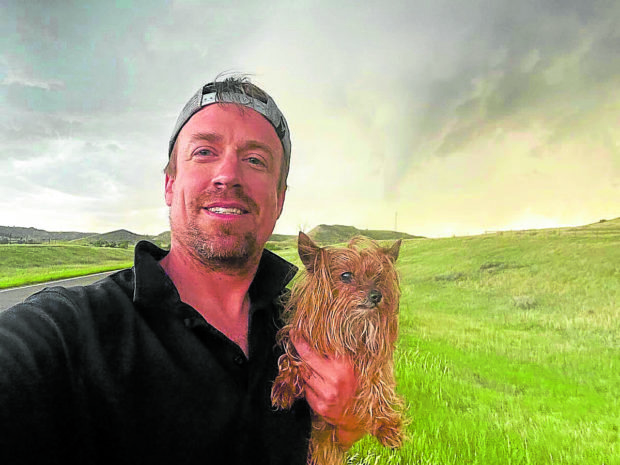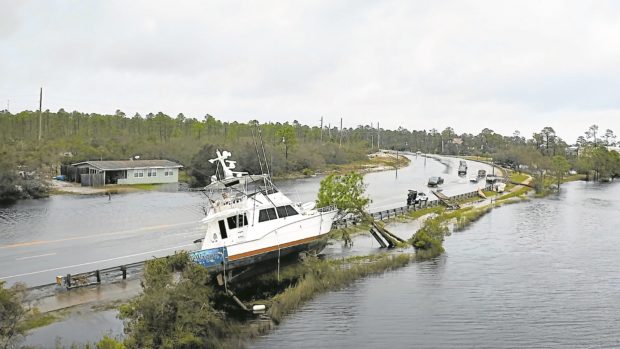‘Storm Rising’: How Reed Timmer’s plan to chase a typhoon in PH was foiled by the pandemic
Extreme weather conditions have been wreaking havoc in many places around the globe in recent years, reaching frightening new levels of intensity due to global warming. This is particularly more troubling in countries located along the typhoon belt in the Pacific—like the Philippines, which is visited by an average of 20 typhoons, five of them destructive, every year.
Growing up, we’ve been forewarned about the unpredictability of the weather. But extreme meteorologist Reed Timmer (“Storm Chasers,” “Tornado Chasers”) and his team are giving it all they’ve got to change that.
This is why science-driven “storm chasers” like Reed feel it’s an urgent endeavor whose benefits outweigh the risks.
These days, they’re inching closer and closer into the so-called “eye of the storm” to measure temperature, pressure and humidity, along the way helping “demystify” weather patterns and establishing a system that could predict the weather and decrease the damage and loss of lives they leave in their wake.
‘Storm Rising’
Along with his storm-chasing partner, photographer Mike Theiss, Reed, with his trusty 12-year-old canine sidekick Gizmo by his side, headlines the five-episode documentary series “Storm Rising,” which launches at 9 p.m. on National Geographic Channel today.
In the docu, Reed and Mike are seen tracking down extreme weather events, collecting data on the ground—and just barely making it out of harm’s way!
So, we were only too happy to chat with Reed on Zoom last month about his thoughts on the unprecedented destruction brought about by worsening weather conditions on the planet and how much deadlier these storms have become.
As an added treat, we had our own one-on-one moment with Gizmo, whom Reed picked up after the storm-chasing, scene-stealing pooch wouldn’t stop barking in the background! Gizmo, we were told, has seen more than 200 tornadoes in her adventures with her doting master.
“‘Storm Rising’ focuses on many more storms, tornadoes and the hurricanes we chase,” stated Reed, when we asked him how different the series would be from his other popular shows. “We were meant to chase a typhoon in the Philippines to start the series, but then the pandemic hit and all the borders were closed. These days, we’re also putting more focus on wildfires and other storms.
“The fast-paced first season includes the record-breaking year that was, for the hurricanes in 2020, with multiple landfalls across the Gulf Coast. We’re also focused on studying climate change and how the storms are changing over time.”
Moreover, there’s a lot more science involved now.
“As you may have seen in the screeners, we’re deploying hardware inside these storms to measure the surge, wind speed and other meteorological data in real time, to understand them better, whereas ‘Storm Chasers’ was more about pure tornado-chasing,” he explained.
Childhood dream
We sat through all five episodes and found the show as entertaining as it was informative—with portions of it guaranteed to remind viewers of either MacGyver (with improvised contraptions created on the fly), James Bond (Reed relies on Q-channeling Mark Simpson in Canada for the latest in technology) or Batman going to crime-busting war in his Batmobile.
In Reed’s case, his custom-made vehicle is the Dominator Fore, a sturdy van made up of a factory-sheet metal body to protect its passengers against the impact of what he calls “gorilla hail storms.”
“If you think there are similarities to Batman, that would make Mike Batman and me Robin (laughs),” Reed quipped. “Seriously, I think I was about 5 years old when I realized I wanted to be a storm chaser—I’ve always known that was what I wanted to do.
“Initially, I was scared to death of thunder and lightning. But there’s a fine line between fear and curiosity, and I just developed a deep passion for storms.
“I did get married, briefly, only for a few months, and I think that chasing storms is my lifelong passion. Doing anything else would only take time away from that. I plan to chase as many storms as possible over the next 40 to 50 years.“I started chasing storms when I got my license at 16. I realized that I didn’t have to wait for storms to come to me, but I could go after them and see a lot more that way. My first tornado was in October 1998, when I first moved to the University of Oklahoma. I’ve been storm chasing nonstop since.
Science-driven
“For the last 25 years, I’ve seen dozens of hurricanes and over 700 tornadoes. And we’re definitely focused on doing more of the science, deploying subsonic sensors into the path of the tornado.
“Mark is like our mad scientist, a genius who builds these live-streaming sensors that we can launch into storms by rocket, balloon or ground probe, like the ones you saw in ‘Storm Rising.’ These allow us to collect data that other people cannot safely collect. He can build advanced technology on the fly, and comparing him to Q from the James Bond movies is accurate (laughs).”

Reed Timmer (left) in a selfie with his dog Gizmo in front of the latter’s 200th tornado —PHOTO FROM TIMMER’S TWITTER ACCOUNT
Excerpts from our Q&A with Reed:
What do you want viewers to take away from this particular series?
We live in a van the entire season. I’d like viewers to see the lifestyle involved in storm chasing as we collect scientific data inside of them. I want people to see the dichotomy of the storms, their physical beauty when people see them out on the plains, as well as understand the dark side that they leave behind—and that’s the sort of damage we’re trying to prevent.
It’s important to enhance our understanding of these storms and see how they’re changing over time, because it does seem like they’re getting worse. Our goal is just to continue to storm chase, because these storms aren’t going to chase themselves.
How has technology evolved since you chased a storm for the first time?
Technology has advanced dramatically since I started storm chasing 25 years ago. Back then, we didn’t even have cellphones—we’d have to pull over and use a payphone to call somebody who’s watching data to find out where that storm is located. Now, it’s just mobile technology, and it’s a lot easier to track down storms.
Computer forecasts have also become incredibly more advanced. They can predict how these storms weigh out in advance, especially the super typhoons that regularly hit the Philippines. A lot of times, they will wobble at the last second there in the tropics, so it’s a little more difficult to predict those.
This is where the newest technologies, like the “surginator probes,” come in—we’re trying to measure the depth of the storm surges and the complexity of the flooding as it comes in. Hopefully, we can bring this technology out to the Philippines this upcoming typhoon season, with the pandemic coming to a close.
This technology will help us better understand super typhoons like Haiyan (Yolanda), because you in the Philippines are dealing with the strongest storms on the planet. There are going to be more storms like this that are becoming stronger and more powerful, so we want to be there to understand their impact better.
Of the hundreds of hurricanes and twisters you’ve crossed paths with, what were the scariest?
Some of the scariest moments were associated with Hurricane Katrina, back in 2005, in southeastern Louisiana. Our vehicle was flooded out by a 15-foot storm surge. We caught a fishing boat, then we had to hitchhike through the damaged path exiting in Jackson, Mississippi.
In terms of tornadoes, I’ve already chased so many of them, oftentimes inside the tornado itself, but the very large hail got really scary when it was blowing out all of our windows in the Dominator van while massive chunks of ice were coming down from the sky. That was definitely an intense moment!
But I get more excited about a storm. I feel like it’s a living, breathing organism that I’m almost communicating and coexisting with. INQ“Storm Rising” premieres at 9 p.m. today on National Geographic Channel (channels 41/195 on SkyCable; channels 141/240 on Cignal).
